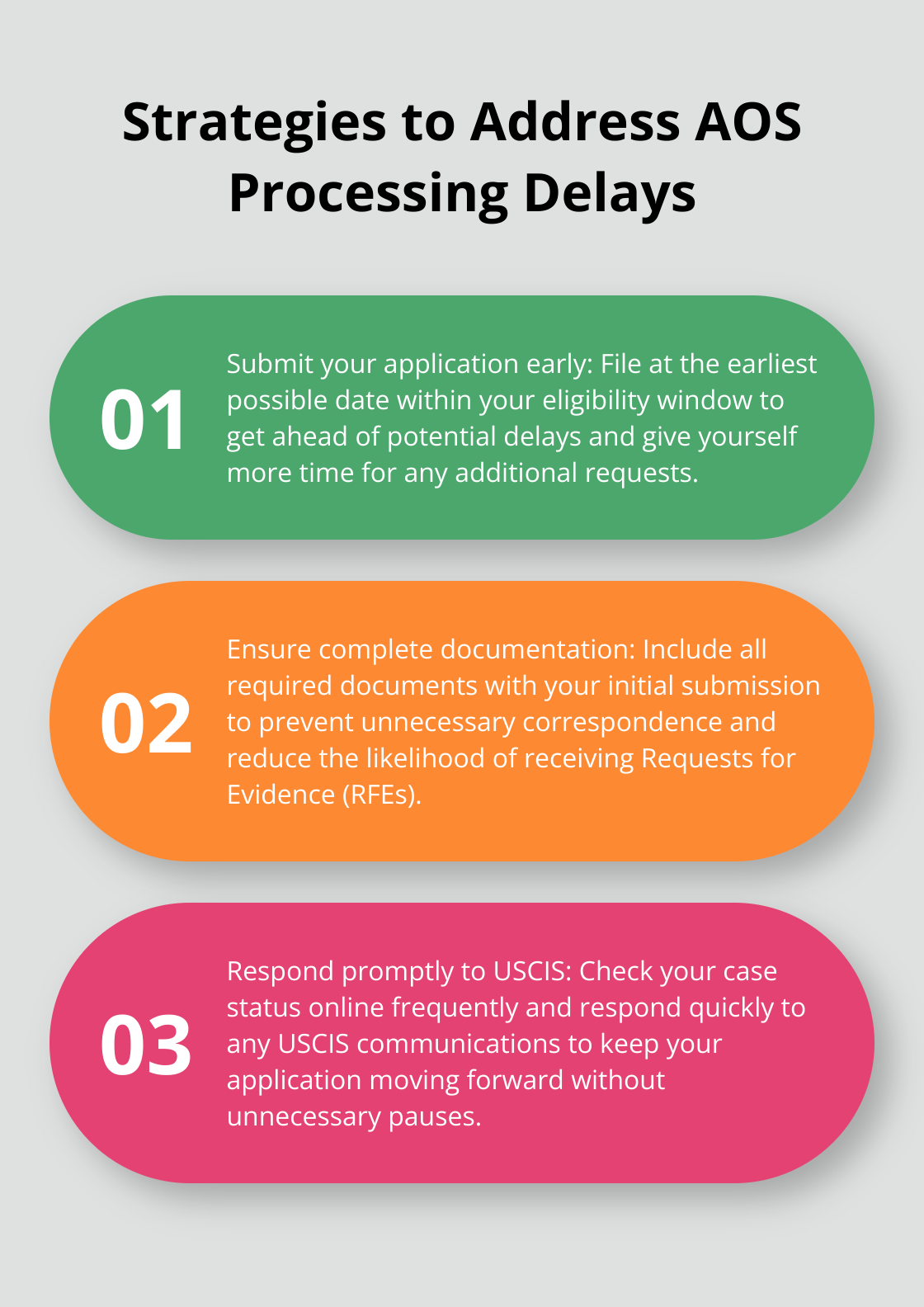
How to Navigate Adjustment of Status in 2025
Navigating the Adjustment of Status process in 2025 can be complex and overwhelming. Recent changes have made it even more challenging for applicants to understand the requirements and procedures.
At Law Offices of Jeffrey A. Thompson, we’ve seen firsthand how these updates impact individuals seeking permanent residency. This guide will walk you through the key steps, potential obstacles, and strategies for a successful Adjustment of Status application in 2025.
What is Adjustment of Status in 2025?
Definition and Purpose
Adjustment of Status (AOS) allows individuals already in the United States to become lawful permanent residents without leaving the country. In 2025, this process has undergone significant changes, making it essential to understand its current nuances.
Updated Eligibility Criteria
The U.S. Citizenship and Immigration Services (USCIS) has revised the eligibility requirements for AOS in 2025. Applicants must now have resided continuously in the United States after their lawful permanent resident (LPR) status. This change aims to reduce fraudulent applications and ensures that only those with genuine ties to the country can adjust their status.
Modernized Application Process
USCIS has launched a new online portal for AOS applications, which has significantly reduced processing times. Recent USCIS data shows that the processing times for AOS applications vary. However, this efficiency comes with stricter documentation requirements. Applicants must now provide comprehensive digital records of their employment history, tax returns, and proof of continuous residence.
Intensified Background Checks
In 2025, USCIS has implemented more rigorous background checks for AOS applicants. This includes an expanded review of social media profiles and increased cooperation with international law enforcement agencies. While these measures have improved security, they’ve also resulted in longer wait times for applicants from certain countries.
Impact on Applicants
These changes have made the AOS process more complex and demanding. Applicants now face stricter scrutiny and must provide more detailed documentation. The new online system, while more efficient, requires a higher level of digital literacy. Additionally, the intensified background checks mean that applicants must be prepared for a more thorough examination of their personal and professional history.

As we move forward, it’s important to understand how these changes affect the steps involved in filing for Adjustment of Status. The next section will outline the specific procedures and requirements for submitting an AOS application in 2025.
How to File for Adjustment of Status in 2025
Preparation of Essential Documents
The Adjustment of Status process in 2025 requires meticulous document preparation. USCIS now demands a more comprehensive set of evidence. Applicants must provide:
- Evidence of continuous residence since obtaining LPR status
- Complete employment history for the past five years
- Tax returns for the last three years
- Comprehensive medical records
- Detailed travel history
Create a checklist and start collecting these documents well in advance to avoid setbacks.

Completion of Form I-485
Form I-485 serves as the cornerstone of your Adjustment of Status application. In 2025, this form includes additional sections on social media presence and extended family information.
When completing Form I-485, focus on:
- Date consistency across all documents
- Accurate reporting of all addresses
- Detailed explanations for any employment or education gaps
Double-check every entry and consider professional assistance for application review.
Biometrics Appointment and Interview Process
After application submission, USCIS will schedule a biometrics appointment. In 2025, USCIS employs advanced biometric technology to capture more detailed data. This appointment holds significant importance – failure to attend can result in automatic application denial.
The interview process has evolved as well. USCIS officers now access a broader range of applicant information, including social media activity. Prepare for questions about:
- Your online presence and digital footprint
- Specific aspects of your employment history
- Details about your family relationships
Consider conducting mock interviews to build confidence and identify potential areas of concern.
Navigating Potential Challenges
The Adjustment of Status process in 2025 presents unique challenges. Applicants may face longer processing times due to enhanced background checks. USCIS has also implemented stricter scrutiny of employment history and financial stability.
To overcome these hurdles:
- Maintain accurate and up-to-date records
- Respond promptly to any USCIS requests for additional information
- Stay informed about changes in immigration policies
The next chapter will address common challenges in the Adjustment of Status process and provide strategies to overcome them effectively.
Overcoming Adjustment of Status Hurdles in 2025
Processing Delays: A Major Challenge
The Adjustment of Status process in 2025 presents several obstacles that applicants must overcome. Processing delays stand out as a significant issue. To address these delays:
- Submit your application at the earliest possible date within your eligibility window.
- Include all required documents with your initial submission to prevent unnecessary correspondence.
- Consider premium processing (if available for your visa category). This option costs more but can speed up the process significantly.
- Check your case status online frequently and respond quickly to any USCIS communications.

Effective Responses to Requests for Evidence
Requests for Evidence (RFEs) have become more prevalent in 2025. When you receive an RFE:
- Examine the request thoroughly and address each point specifically.
- Provide extensive documentation that exceeds the minimum requirements.
- Submit your response well before the deadline to allow for any unexpected issues.
(Legal assistance can prove invaluable in crafting a comprehensive and persuasive response to an RFE.)
Navigating Complex Family and Employment Situations
Family dynamics and employment changes can complicate the AOS process. USCIS has implemented stricter scrutiny of these situations in 2025. To manage them effectively:
- Inform USCIS immediately of any changes in family status or employment.
- Keep detailed records of all life events and job transitions.
- Prepare to provide evidence of continued financial stability if your employment situation changes.
(For marriages during the AOS process, expect additional scrutiny and be ready to provide extensive proof of the relationship’s legitimacy.)
Staying Informed and Prepared
The AOS process in 2025 requires patience, attention to detail, and often, expert guidance. To stay ahead:
- Monitor USCIS updates and policy changes regularly.
- Maintain a file of all your immigration-related documents, easily accessible when needed.
- Consider seeking professional legal advice for complex cases or if you encounter difficulties during the process.
It’s important to note that family reunification policies can significantly impact the AOS process, with some categories facing wait times of over two decades. Additionally, applicants should be aware that drug convictions can severely affect their eligibility for adjustment of status.
Final Thoughts
The Adjustment of Status process in 2025 demands meticulous planning and a deep understanding of current immigration policies. Applicants face stricter eligibility criteria, modernized procedures, and intensified background checks. These changes have increased the complexity of the journey to permanent residency, but success remains achievable with proper preparation.
Professional legal assistance proves invaluable when navigating the intricacies of Adjustment of Status 2025. An experienced immigration attorney can provide personalized guidance, ensure compliance with all requirements, and help avoid potential pitfalls. Our team at Law Offices of Jeffrey A. Thompson specializes in guiding clients through complex immigration processes, including Adjustment of Status.
We offer comprehensive support from initial consultation to final approval (ensuring your application receives thorough and accurate presentation). Our expertise in the nuances of 2025 requirements and up-to-date knowledge of USCIS policies can significantly improve your chances of a successful outcome. Take proactive steps toward achieving your immigration goals and secure your future in the United States with expert assistance.


